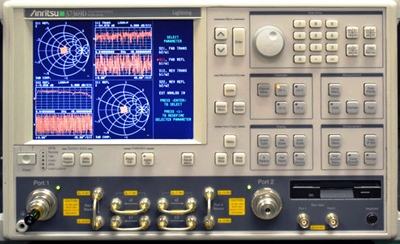
|
|
The Anritsu 37347D 20 GHz Lightning D Vector Network Analyzer (VNA) is a high performance test tool designed to satisfy the growing needs of defense, satellite, radar, broadband communication, and high speed component markets. The 37347D VNA improve upon performance while providing a wider set of standard application features to better suit the needs of R&D engineers working on next generation designs. These new features, when combined with the ease of programming through helpful software utilities and faster data transfer over Ethernet, make it an equally valuable tool for manufacturing as well. This high performance two-port VNAs that include step attenuators, internal bias tees, a gain compression application. Multiple source control and set-on receiver mode allows the frequency of two sources and a receiver to be controlled without the need for an external controller. VNA Utilities is the ultimate solution for automated test software development. It includes fully functional application programs, re-usable calibration, set-up and data manipulation samples, and software development tools for creating custom applications. VNA Utilities includes applications such as the Capture Utility, which allows the user to extract data from the VNA in any of the supported formats (bitmap, S2P, plotter graphics, etc.). Specifications. Frequency Range: 40 MHz to 20 GHz. Port 1 Power, Typical: 10 dBm @ 0.04 GHz (max), 3 dBm @ 20 GHz. Noise Floor at Port 2 (RMS values – compensated for loss in available source power from test port cable connected between Port 1 and Port 2): -85 dBm @ 0.04 GHz, -103dBm @ 20 GHz, Max. -107 dBm @ 2 GHz. System Dynamic Range: 95 dB @ 0.04 GHz, 106 dB @ 20 GHz, Max. 115 dB @ 2 GHz. Measurement Parameters: S11, S21, S22, S12 (User-defined combinations of a1, a2, b1, and b2.). Domains: Frequency Domain, CW Draw, and optional High Speed Time (Distance) Domain. Data Points: 1601 maximum or N discrete data points where 2 <=N <=1601. IF Bandwidth: 10 kHz to 10 Hz. GPIB: 2 Ports, system GPIB and dedicated GPIB. Display: Color LCD, 8.5" diagonal. Option 1A Rack mount kit with handles only (no slides). Option 2A Time Domain (Distance) measurement capability. Option 4A External SCSI-2 hard disk drive compatibility. Option 7A Replaces K test port connectors with GPC-7 connectors. Option 7N Replaces K test port connectors with N(m) connectors. Option 7NF Replaces K test port connectors with N(f) connectors. Option 7S Replaces K test port connectors with 3.5 mm-(m) connectors. Option 15 Flexible test set.
|